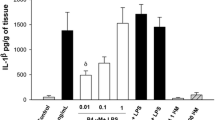Abstract
These experiments aimed to understand the relationship between interleukin 10 (IL10), the IL10 receptor subunits, and progesterone (P4) at the time of parturition. We hypothesized that there is a biologic connection between IL10 and P4, supporting an immunomodulatory mechanism for the onset of labor. Using samples from control and P4-treated pregnant mice, we assessed the production of IL10 and its receptor subunits (IL10Rα and IL10Rβ) in gestational tissues. After preliminary studies, P4-treated pregnant mice were compared with controls to assess for differences in IL10 and IL10 receptor subunit expression throughout gestation. To investigate the contribution of the P4 receptor at the onset of labor, we performed timed studies on pregnant mice after treatment with RU486. Samples collected included placentas, placentation sites, and maternal livers. IL10, IL10Rα, and IL10Rβ levels were measured in homogenized tissue using ELISA assays; the cytokine results were normalized for homogenate protein concentration. Control mice delivered on gd 18–19, and P4 treatment prevented parturition to beyond gd 20, as expected. In treated mice, P4 not only prevented the anticipated nadir of IL10 at term, but maintained elevated levels of IL10 through gd 20 (p < 0.05). P4 also reversed the anticipated decrease of the IL10Rα, which was increased in P4-treated mice (p < 0.05). Treatment with RU486 did not modulate the expression of IL10 or IL10Rα, but showed a significant decrease in the level of IL10Rβ (p < 0.05). Progesterone functions at least in part through the IL10 signaling pathway to prolong gestation.




Similar content being viewed by others
References
Nold C, Maubert M, Anton L, Yellon S, Elovitz MA. Prevention of preterm birth by progestational agents: what are the molecular mechanisms? Am J Obstet Gynecol. 2013;208:223.e1–7.
Phillippe M. Cell-free fetal DNA—a trigger for parturition. N Engl J Med. 2014;370:2534–6.
Thaxton JE, Romero R, Sharma S. TLR9 activation coupled to IL-10 deficiency induces adverse pregnancy outcomes. J Immunol. 2009;183:1144–54.
Hashimoto H, et al. Comparative study of doses of exogenous progesterone administration needed to delay parturition in Jcl:MCH(ICR) Mice. Exp Anim. 2010;59:521–4.
Meis PJ, Klebanoff M, Thom E, Dombrowski MP, Sibai B, Moawad AH, et al. Prevention of recurrent preterm delivery by 17 alpha-hydroxyprogesterone caproate. N Engl J Med. 2003;348:2379–85.
Pineda-Torres M, et al. Evidence of an immunosuppressive effect of progesterone upon in vitro secretion of proinflammatory and prodegradative factors in a model of choriodecidual infection. BJOG Int J Obstet Gynaecol. 2015;122:1798–807.
Murphy SP, Fast LD, Hanna NN, Sharma S. Uterine NK cells mediate inflammation-induced fetal demise in IL-10-null mice. J Immunol. 2005;175:4084–90.
Sun Y, et al. Differential effects of the CpG-toll-like receptor 9 axis on pregnancy outcome in nonobese diabetic mice and wild-type controls. Fertil Steril. 2013;99:1759–1767.e4.
Trautman MS, Collmer D, Edwin SS, White W, Mitchell MD, Dudley DJ. Expression of interleukin-10 in human gestational tissues. J Soc Gynecol Investig. 1997;4:247–53.
Hanna N, et al. Evidence for interleukin-10-mediated inhibition of cyclo- oxygenase-2 expression and prostaglandin production in preterm human placenta. Am J Reprod Immunol N Y N. 2006;1989(55):19–27.
Simpson KL, Keelan JA, Mitchell MD. Labor-associated changes in interleukin-10 production and its regulation by immunomodulators in human choriodecidua. J Clin Endocrinol Metab. 1998;83:4332–7.
Szony BJ, et al. Interleukin-10 receptors are expressed by basement membrane anchored, alpha(6) integrin(+) cytotrophoblast cells in early human placenta. Mol Hum Reprod. 1999;5:1059–65.
Sugimoto Y, et al. Failure of parturition in mice lacking the prostaglandin F receptor. Science. 1997;277:681–3.
Luo G, Abrahams VM, Tadesse S, Funai EF, Hodgson EJ, Gao J, et al. Progesterone inhibits basal and TNF-α-induced apoptosis in fetal membranes: a novel mechanism to explain progesterone-mediated prevention of preterm birth. Reprod Sci. 2010;17:532–9.
Mu J, Kanzaki T, Tomimatsu T, Fukuda H, Wasada K, Fujii E, et al. Expression of apoptosis in placentae from mice lacking the prostaglandin F receptor. Placenta. 2002;23:215–23.
Smith S, Baker PN, Symonds EM. Placental apoptosis in normal human pregnancy. Am J Obstet Gynecol. 1997;177:57–65.
Fonseca EB, Celik E, Parra M, Singh M, Nicolaides KH, Fetal Medicine Foundation Second Trimester Screening Group. Progesterone and the risk of preterm birth among women with a short cervix. N Engl J Med. 2007;357:462–9.
Hassan SS, et al. Vaginal progesterone reduces the rate of preterm birth in women with a sonographic short cervix: a multicenter, randomized, double-blind, placebo-controlled trial. Ultrasound Obstet Gynecol Off J Int Soc Ultrasound Obstet Gynecol. 2011;38:18–31.
Phillippe M. Cell-free fetal DNA, telomeres, and the spontaneous onset of parturition. Reprod Sci. 2015;22:1186–201.
Reinhard G, Noll A, Schlebusch H, Mallmann P, Ruecker AV. Shifts in the TH1/TH2 balance during human pregnancy correlate with apoptotic changes. Biochem Biophys Res Commun. 1998;245:933–8.
Alimohamadi S, Javadian P, Gharedaghi MH, Javadian N, Alinia H, Khazardoust S, et al. Progesterone and threatened abortion: a randomized clinical trial on endocervical cytokine concentrations. J Reprod Immunol. 2013;98:52–60.
Lissauer D, et al. Progesterone promotes maternal–fetal tolerance by reducing human maternal T-cell polyfunctionality and inducing a specific cytokine profile. Eur J Immunol. 2015;45:2858–72.
Nadeau-Vallée M, et al. Sterile inflammation and pregnancy complications: a review. Reprod Camb Engl. 2016;152:R277–92.
Romero R, Dey SK, Fisher SJ. Preterm Labor: One syndrome, many causes. Science. 2014;345:760–5.
Christiaens I, Zaragoza DB, Guilbert L, Robertson SA, Mitchell BF, Olson DM. Inflammatory processes in preterm and term parturition. J Reprod Immunol. 2008;79:50–7.
Norman JE, Bollapragada S, Yuan M, Nelson SM. Inflammatory pathways in the mechanism of parturition. BMC Pregnancy Childbirth. 2007;7:S7.
Funding
This work was funded by the Burroughs-Welcome Fund Preterm Birth Initiative.
Author information
Authors and Affiliations
Corresponding author
Ethics declarations
Institutional Animal Care and Use Committee (IACUC) approved animal research protocol: 2014 N000219 https://iacuc.hms.harvard.edu/
Conflict of Interests
The authors declare that they have no conflict of interest.
Additional information
Publisher's Note
Springer Nature remains neutral with regard to jurisdictional claims in published maps and institutional affiliations.
Rights and permissions
About this article
Cite this article
Liff, I., Adeli, S., Goldfarb, I.T. et al. Modulation of IL10 and Its Receptor Subunits in Normal and Progesterone-Prolonged Gestation in the Mouse. Reprod. Sci. 27, 555–560 (2020). https://doi.org/10.1007/s43032-019-00022-7
Received:
Accepted:
Published:
Issue Date:
DOI: https://doi.org/10.1007/s43032-019-00022-7




